 Dear Wisconsin nursery growers, Christmas tree growers, and gardeners,
We hope you have been enjoying autumn in Wisconsin. Below are some field updates, including many items of interest to Christmas tree growers. Please send any feedback, questions, or ideas you have for future e-news updates to datcpnursery@wisconsin.gov.
Having trouble viewing this email? View it as a Web page.
Watch Out for the State-regulated European Pine Shoot Moth
Following the recent federal deregulation of pine shoot beetle, the Wisconsin Department of Agriculture, Trade and Consumer Protection (DATCP) polled regulators in a few states to determine whether they would regulate that pest at the state level. While none plan to regulate pine shoot beetle, the exterior state quarantine for European Pine Shoot Moth (EPSM) Rhyacionia buoliana, is still in place in Montana, California, and Hawaii. This means that Wisconsin Christmas tree growers shipping pine Christmas trees or other regulated articles to those states must adhere to the requirements outlined in the regulatory summaries posted on the National Plant Board website.
EPSM infests Scotch, red, Mugo, eastern white and other types of pines. It overwinters in the larval stage in tunnels lined with silk inside host plant buds. Larval feeding results in deformed or crooked shoots and branches and trees with dead, spiked tops. Small orange and white EPSM adults are active during summer. Management includes pruning out infested branches and chemical treatments. More information on EPSM is available on the PSU Extension website.
DATCP has been trapping in some Jackson County fields in recent years for this introduced pest of ornamental pines and Christmas trees, first recorded in the U.S. in 1914. While DATCP has not detected adult moths in traps from 2019-2021, it is important to continue surveys and inspections to avoid introducing EPSM to new areas. Larval EPSM have been detected in Scotch and Mugo pine nursery samples from Sheboygan County in 2018 and 2021. Please let your local inspector know if you plan to ship pines to states with EPSM regulations, or if you think you have seen this pest on your pines.
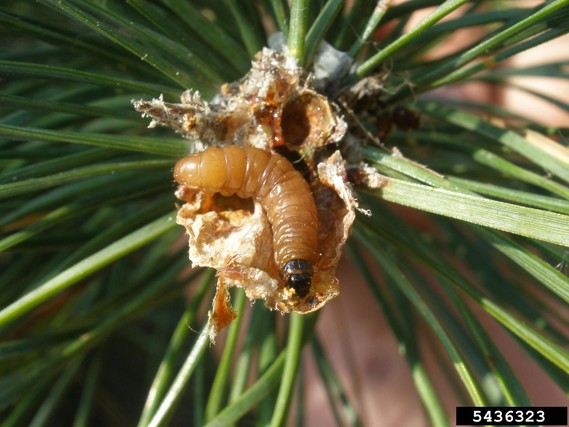 European Pine Shoot Moth larva, Mariusz Sobieski, Bugwood.org
Help Protect Wisconsin from Introduced Pests and Diseases on Holiday Décor
DATCP will be conducting inspections at Christmas tree lots again this year. Based on interceptions over the past few years, our primary concern is the movement of elongate hemlock scale (EHS) on fir trees, wreaths, or other holiday décor into Wisconsin. More information about elongate hemlock scale can be found on our website.
While EHS has received a lot of attention recently, there are other injurious pests and diseases that could hitchhike into Wisconsin on holiday materials as well, including gypsy moth, boxwood infected with boxwood blight, and the restricted invasive oriental bittersweet, which cannot legally be sold in Wisconsin. Similar to last holiday season, during 2021 we will be ordering infested, infected, or invasive material to be removed from sale. Please take steps to work with your suppliers to make sure that plants with these issues are not sent to Wisconsin.
Thank you for your partnership in proactively addressing these issues, and please contact Christmas tree program coordinator Brooke Sanneh at brooke.sanneh@wisconsin.gov with any questions or concerns you have about these regulations.
 Image of Elongate Hemlock Scale, showing white winged males and brown females on fir needle undersides
Spruce Harlequin Caterpillar Detected on Balsam Fir
During recent Christmas tree field inspections in Langlade and Price counties, inspectors observed Spruce Harlequin caterpillars (also known as Dark Spotted Palthis) on balsam fir. This is a native insect known to occur across much of North America. The caterpillar, or larvae, is active between June and October. It is typically found in moist forest habitats. The Spruce Harlequin caterpillar is considered a generalist and feeds on white spruce, balsam fir, ash, alder, maple, and willow.
Spruce Harlequin caterpillar is not an insect pest of economic or regulatory concern. Treatment is not recommended, as feeding damage in Christmas tree plantations is considered to be minimal. Still, it is always interesting to observe and make note of late-feeding insects in Christmas tree fields this time of year.
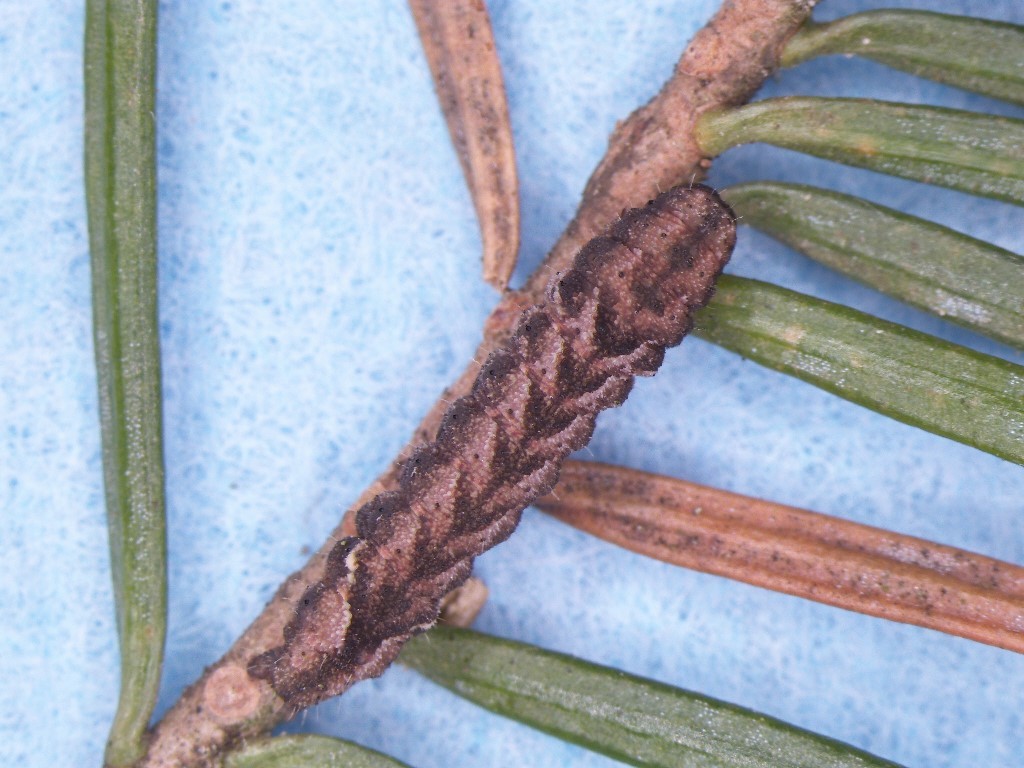 Spruce Harlequin Caterpillar in Wisconsin Christmas tree field
Non-native Cryptomeria Scale Intercepted on Hemlock Nursery Stock
In late September, an inspector in southeastern Wisconsin found live Cryptomeria scale on hemlock nursery stock. The nursery stock was purchased from an Ohio broker. The infested hemlocks were removed from sale and destroyed.
Cryptomeria scale, Aspidiotus cryptomeriae, is an armored scale (Order Hemiptera: Family Diaspididae, in the same family as elongate hemlock scale or EHS) that was introduced into North America from Japan. This serious conifer pest, which causes yellow needle mottling on lower and inner branches and severe needle drop, is not established in Wisconsin, but it is found in a handful of eastern states, including Connecticut, Massachusetts, North Carolina, Ohio, and Pennsylvanie. Cryptomeria scale resembles a tiny fried egg on the undersides of needles (it is circular, yellow in the middle, and has a white outer ring). Besides hemlock (Tsuga), other hosts include fir (Abies), spruce (Picea), pine (Pinus), Douglas fir (Pseudotsuga), yew (Taxus), and false cypress (Chamaecyparis). Adult females are yellow, immobile, and can lay up to 40 eggs under their protective wax coating. Adult males are winged, short-lived, and rarely seen.
If you are buying conifer nursery stock or Christmas trees from another state, safeguard your business by taking these precautions:
- Require suppliers to inform you of the source of conifers you order (Note: It is crucial to identify where plants were grown, not just the broker's location). Our state’s Hemlock Woolly Adelgid (HWA) quarantine requires hemlock stock to be sourced from outside the infested area or accompanied by a phytosanitary certificate (unless you have a HWA compliance agreement with us), and that stock is free of injurious pests and diseases.
- Buy conifers from outside known HWA, EHS, and Cryptomeria scale-infested areas.
- Inspect all plant material closely. Contact your local inspector if you think your plants might be infested with Cryptomeria scale or other pests.
Thank you for doing your part to ensure harmful pests do not enter or become established in Wisconsin, where they will threaten our Christmas tree and nursery industries.
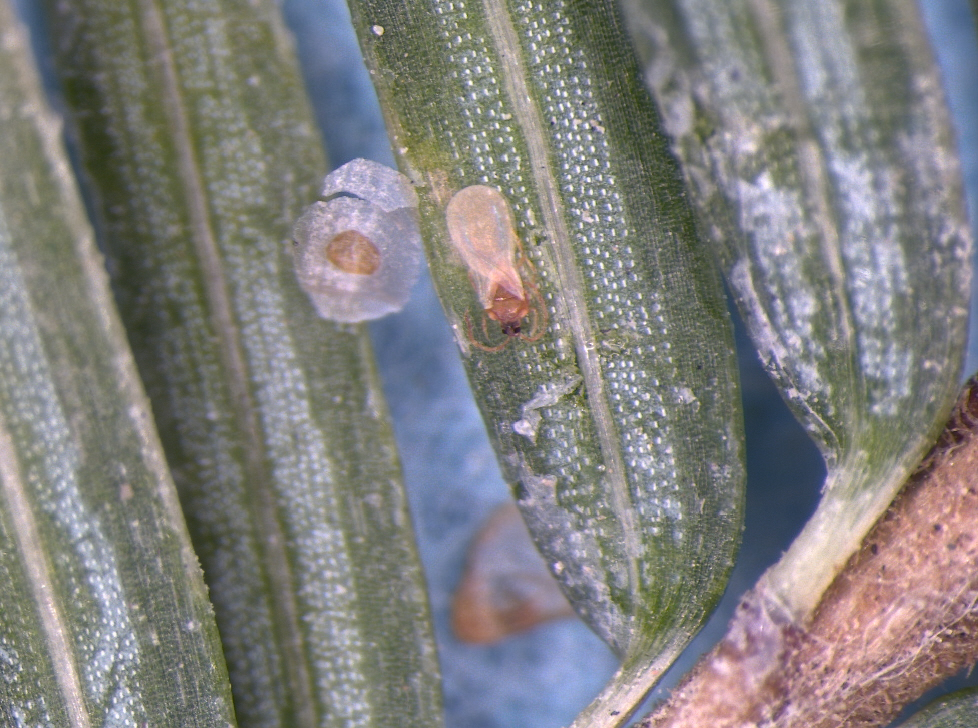 Male Cryptomeria Scale with Test Removed, Renee Pinski, DATCP
Introduced Pine Sawfly Observed on White Pine in Lincoln County
Several introduced pine sawfly larvae were observed feeding on an eastern white pine during Lincoln County Christmas tree inspections this September. Introduced pine sawfly, or Diprion similis, was accidentally introduced from Holland to Connecticut in 1914. Larval introduced pine sawflies prefer to feed on eastern white pine, but may also infest Austrian, Scotch, red, jack, and Mugo pine. Defoliation is usually most severe in the upper half of the trees, where we observed them during our inspection; whole trees can be defoliated when populations are high. There are two generations per year, with the first one occurring in early to mid-summer, followed by a second generation with larvae present in late summer and early fall. The first generation feeds on the previous year's needles, while the second generation feeds on both old and new needles. Larvae overwinter as prepupae before tiny, stocky, yellow and black wasp-like adults come out in spring. Two parasitic wasps from eastern North America, Exenterus amictorius and Monodontomerus dentipes, appear to control larvae and cocoons respectively, making chemical controls rarely needed for this pest.
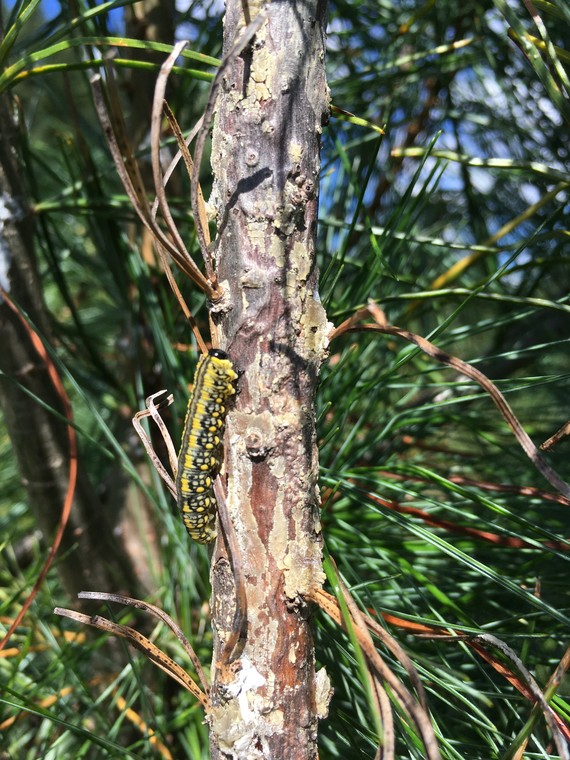 Pay Attention to the Roots: Careful Planting Is Crucial for Transplant Success, Tree Health
A healthy, well-structured root system is critical for success in growing landscape nursery stock and Christmas trees. When inspecting growing fields and investigating failed transplants, digging up or pulling out failed transplants often reveals poor root systems. Girdling roots are often found; the root systems are tangled and appear to have been held in propagation systems (Ellepots, grow plugs, plug trays, or containers) for far too long (see image below). J-root formation from mechanical planting in shallow trenches is also found. Sometimes root rot is part of the equation.
Pathogens, like Phytophthora, may already be established in your field, or may be introduced on the transplant’s roots. Many failed transplants have been planted too deep, resulting in stems being invaded by pathogens or root collar insect pests, as they are not suited for contact with soil.
We also encounter mechanical injury to roots, root collars, and stems or trunks resulting from overzealous cultivation practices. Wounding can invite all kinds of pathogens and insect pests. If transplants manage to become established despite having a poor root system, root collar damage, or lower trunk injuries, the end result is often longer crop cycles, added costs, and lost stock quality and profitability. DATCP inspectors are mainly charged with checking for regulatory plant pests and diseases, but it is important to remember just how crucial proper planting can be.
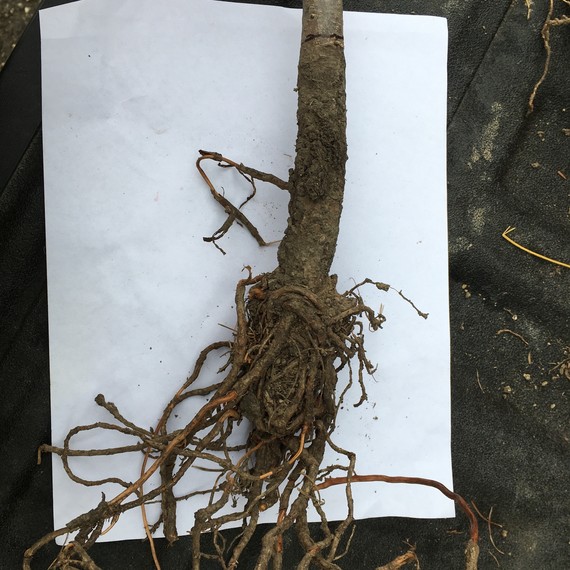 Learn More
For more information about Wisconsin's Nursery Program, visit DATCP's Nursery and Christmas Tree Program webpage.
Division of Agricultural Resource Management | Bureau of Plant Industry
Having trouble viewing this email? View it as a Web page.
|